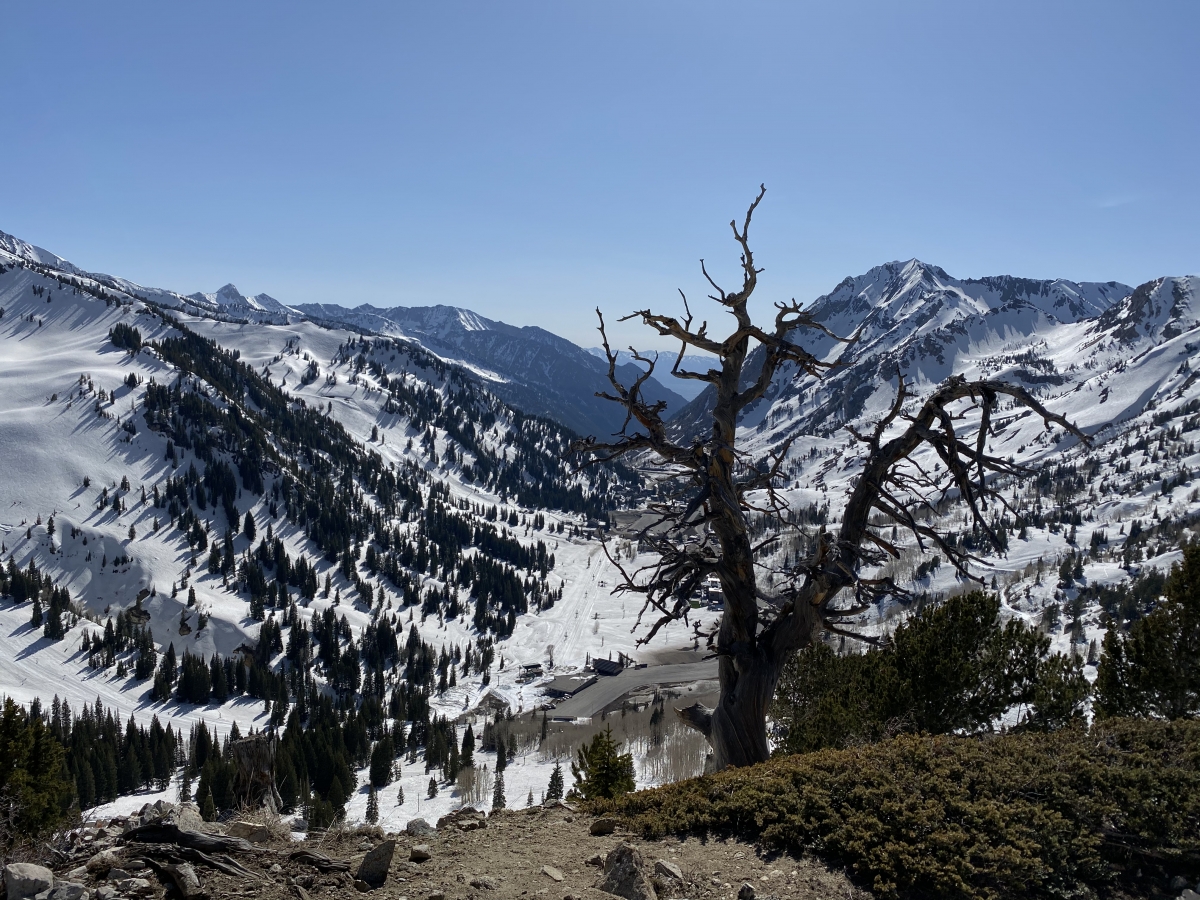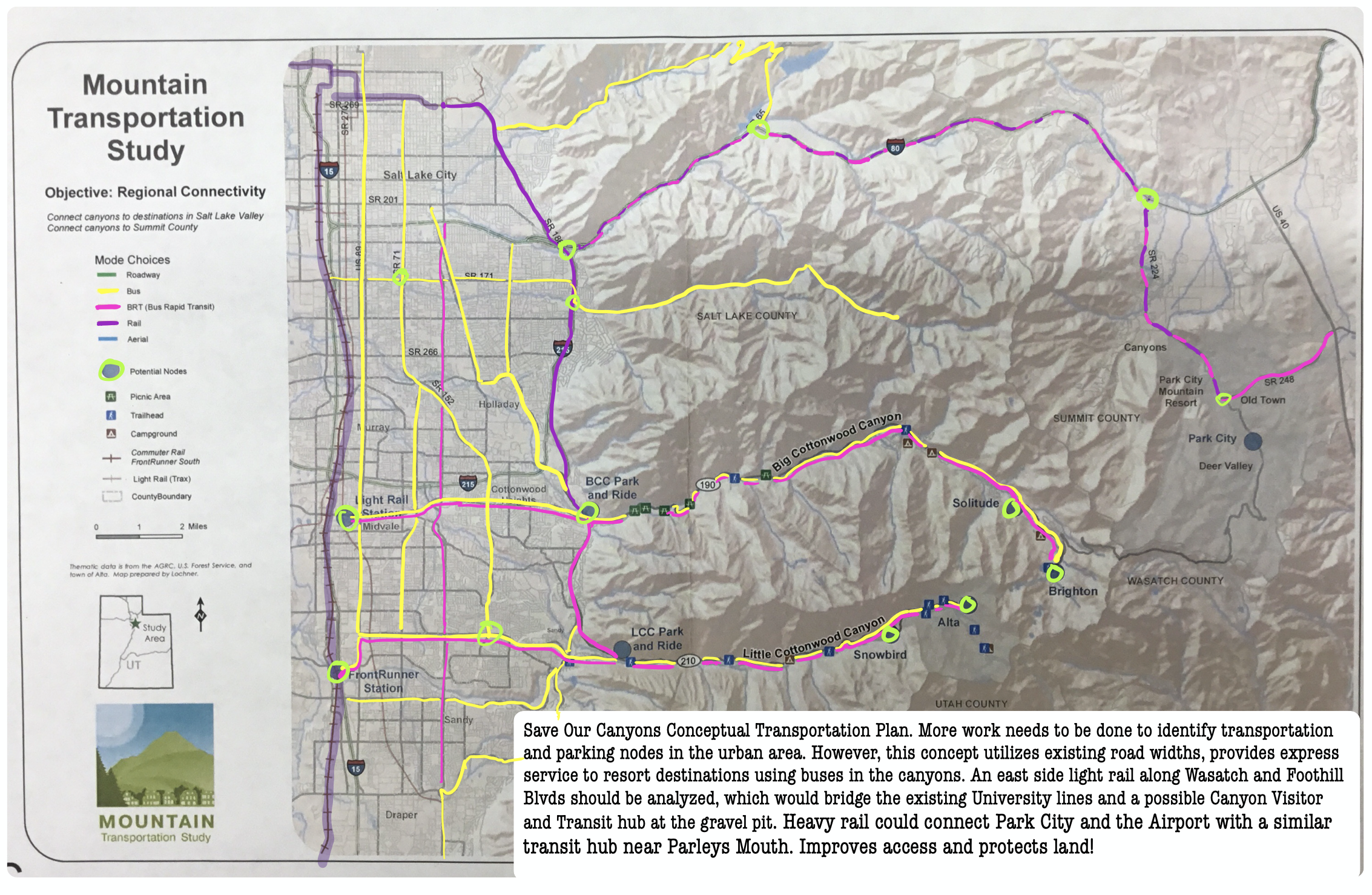Watch the Save Our Canyons Transportation Presentation Zoom Hangout Video
View the ![]() Power Point Presentation from Zoom Hangout; July 7th, 2020
Power Point Presentation from Zoom Hangout; July 7th, 2020
Submit Comment: UDOT Little Cottonwood Canyon EIS Public Comment Form
As resorts come up with new ways to market themselves, we are being asked to sacrifice the environment and foot the bill to ensure their continued success. This is by its very definition, unsustainable. How much more taxpayer money will be spent to support resorts and destroy our canyons? The natural constraints of mountains are what make them, well, mountains.
It’s no secret that we’ve been skeptical that UDOT's Little Cottonwood EIS could yield positive outcomes for our intensely loved and incredibly important Wasatch Canyons. As the process has worn on, which the former project manager urged us to “trust”, no only has our trust been continuously betrayed, but it is clear that there are a few things UDOT has concerned itself with, and none of their concerns stand to benefit the region, our communities, the users and certainly not the environment. We now know why the State has fought protection of the Wasatch - it wants to build a massive interconnect - it is plain as day in this EIS. If we can’t agree what the problem is, there’s really no hope in finding a solution, and UDOT has not only rejected input from SOC and our partners, but also rejected input and concerns from watershed managers too.
Unsurprisingly, the State’s priorities are money, tourism, resorts and their road. The “Draft Alternatives Development and Screening Report” was released on June 8th, 2020 and public comment will be open until July 10, 2020. Our goal here is to help you understand the process and the alternatives, and aid you in submitting comments in hopes you can influence the process. Of course, Save Our Canyons, as we do, attempts to draft our own comments that reflect the sentiments of our members. As you can appreciate, a loyal Alta or Snowbird skier who’s relationship with the Wasatch is defined by that activity, could have a very different opinion on what the solution is than a mountain biker, climber, hiker, backcountry skier, hunter or someone whose relationship is drinking water that comes from the canyon.
Before I jump into the Alternatives, let's understand what initiated the EIS. In 2017, the Utah Legislature passed a bill SB 277 - Highway General Obligations Bonds Authorization, which contained a section on what was later referred to as “Recreation Hot Spots”.
The strings attached to this funding said:
(i) have a significant economic development impact associated with recreation and tourism within the state; and
(ii) address significant needs for congestion mitigation.
This passage of this bill triggered a convening of the UDOT Transportation Commission, who ultimately decided $66 million of the $100 million authorized would go to Little Cottonwood Canyon.
Then, in 2019, the Legislature passed SB 268 - Transportation Infrastructure Bond Amendments, which included this provision:
(xvii) $13,000,000 for corridor preservation and land acquisition for a transit hub at the mouth of Big Cottonwood Canyon;
These few provisions set the stage for the process we are now in. It is also worth noting that when the Little Cottonwood EIS (LCC EIS) first started up, there was also a promise of simultaneously doing a more holistic approach called the Cottonwood Canyons Transportation Action Plan (CCTAP), which was to be done in partnership with the Central Wasatch Commission. In 2019, UDOT reneged on its promise to be comprehensive and collaborative, killed CCTAP and abruptly resigned from the Central Wasatch Commission. The Central Wasatch Commission’s stakeholders were certainly dubious of UDOT’s intent and appeared to be winning favor amongst commissioners who were beginning to ask questions, ultimately leading to UDOTs resignation. The beef: UDOT wasn’t interested in looking at canyon capacities and how the impact of intensifying economic development activities and increasing tourism (as directed by SB 277) would manifest itself in the region, not to mention the impact on our watershed canyons, wildlife populations, and local communities.
Our fears have come to fruition and are documented in the most recent report. UDOT has only concerned itself with their road and the resorts, doubling down on three of Utah’s loves: roads, cars and exploitation and industrialization of our natural wonders. History has demonstrated that we are better at building ourselves into new problems than out of the ones that already exist. All this when overwhelming public sentiments are calling for transit-based solutions and protection of the Wasatch - which really shouldn’t be a hard ask.
With that prelude, let’s get to the so-called alternatives, the solution to the problem no one can agree on. As UDOT has laid it out, there are three options: one is the world's longest and most inefficient gondola, the other two are “enhanced buses”, which could have been good, but the bus is simply an appetizer to a gorging entree of infrastructure projects - more lanes and avalanche sheds. All the alternatives are intensively reliant upon cars, to and within the canyon, which is why a transit agency, rather than a road building agency should be the lead in transit service design.
Gondola
No one is really shocked that after 40-some years of advocating for ski interconnect that the state included a gondola as an alternative. Nevertheless, it is still always jarring to see it documented. The most significant issue with the gondola is, and will continue to be, parking: there is no space to accommodate at least 10,000 vehicles anywhere in the vicinity of the canyons. And since the state throws most of our money at failed road projects, there is no money for transit, so getting to the mouths of the canyons without a car is neither a priority or a possibility.
Most transit planners cringe at having one transfer, but it is more often than not a necessary evil. Two transfers are even less desirable, and three is basically considered a fatal flaw and ineffective transit. Think about it, how many times do you want to move your or your kids’ skis from one mode to another?
The gondola mobility hub (which SB 268 funded), will have about 2,500 spaces for cars. Being that it is located at the mouth of Big Cottonwood, one would assume that some of those stalls would be occupied by folks seeking to carpool or take transit up Big Cottonwood... or will this be exclusive to those going up Little? If you live in Granite, Sandy or Draper, you’ll have to drive past Little Cottonwood to Big, where you’ll enjoy the traffic you are trying to escape before getting on a bus heading back toward whence you came, to then catch the gondola.
If you are visiting the Wasatch for another purpose other than patronizing a resort, you are S.O.L. UDOT’s own traffic data shows the peak that is causing the problems is happening in a 3 hour window. The gondola will only transport about 900 people every hour with about 21,000 people trying to get up the canyon. So about 3,000 people will get up by gondola in this window, and 18,000 will still need to use cars on the road. They claim a reduction of about 350 vehicles per hour, and cite that canyon road closures (which again, 18,000 people will need to rely on) in the gondola scenario will double at best, from today’s 10.4 days (56.3 hours) to 21+ days (108+ hours). This works well for the lucky 3,000, the rest of us will be stuck in the same (or worse) traffic, forced to look at the gondola that ruined the canyon, that you can’t get on because there is no parking, no transit or the road isn’t even open.
Finally, this is not found anywhere in the EIS, rather it was mentioned in a meeting we and other organizations had with UDOT. One “benefit”, they say of the gondola is that they can induce tourism demand in the summer by selling tickets to ride the gondola as if it were a ride at Lagoon. These canyons are enough of an attraction themselves, they don’t need more crap built, exploiting the natural scenery.
As one of our resident transportation experts put it, gondolas are great for places where you can’t build roads, like up a steep mountain. But the road is always going to be more effective and expeditious at transporting people. Little Cottonwood has a road. If we wanted to have the conversation about transporting people without it, let's do it, but that isn’t at all the question or an option UDOT is willing to consider. The gondola fails the canyon, the users, and the resorts.
Avalanche Sheds, Road widening & Berms
These elements accompany the enhanced bus options. It is important to note that UDOT has decided the problems in the Wasatch are not year-round, they really are only 4 or so months of the year, despite year-round intensification of recreational activities, not to mention the year-round impact of climate change causing uncertainty for our water supply, quality not to mention the viability of the ski industry. We currently have about 10.4 days (56.3 hours) that the canyons are closed. The best alternative reduces canyon closures by 4 days (11 hours). So look at these impacts that will fundamentally alter the wildness and beauty of our canyons… for a 4 day (40 hours) benefit for resort skiers.
One scenario has a longer avalanche shed, the other a shorter shed, but with berms and a widened road. All of these proposals will cause impacts to the hydrology and erosive activities in the Wasatch.
Mobility Hubs
Above, I talked a little about the gondola mobility hub. Again, these hubs aren’t inexpensive, they will have traffic impacts, albeit in different locations, but will absolutely cause congestion at peak times. Further, because this is a project that only looks at Little Cottonwood Canyon roadway (UDOT rejected numerous requests to be more comprehensive), the analysis has failed to contemplate usage for Big Cottonwood. Let’s face it, there is a lot of parking lots out there but they aren’t all able to be used to coordinate carpools and transit. It might not be possible to get everyone to the canyons by transit, but we can certainly make a few hubs throughout the valley to aid in getting people to hubs within say, 5 miles from home.
Enhanced Buses
We like the idea of the buses. As mentioned, we take issue with the other elements they’ve attached to the bus. If we can get more people on transit and increase vehicular occupancy (from 1.8 to say 4) there will be less cars in the canyon. Less cars means less need for parking and less need for a lane. Less cars also means less lining up at the mouth. So forward the buses, but without the sheds and the lanes and make these buses penetrate further into our communities in the valley giving more people, better access. You could even run articulated buses from the communities to the mouth (though that would indeed force a transfer). Express buses where Alta patrons don’t have to ride through Snowbird, for example, is a great idea and should be pursued. It should be noted that you shouldn’t need an EIS to just run more buses on the roadway. So you can like buses, and hate this EIS! Fund UTA, not UDOT.
New Parking Lots
This is pretty much the only thing that could benefit the average user of the Wasatch. Of course, parking lots are not environmentally friendly at all. A better option would be to have transit serve some locations. We’d need to figure out, where, how many people, and how it would be managed, but I think we are capable of this. Parking lots are for cars, and again, we thought the entire purpose here was to reduce the number of cars, not make it easier or accommodate them. An integrated trails and transportation access and management plan need to be done for the region, something we’ve advocated for as part of the Central Wasatch NCRA, which is being held hostage until UDOT finishes the EIS. We should design the transportation around the environment, experiences and values we seek for the Wasatch, not design experiences around transportation though modification of the environment. Transportation isn’t the value, it's a tool that can help or hurt those values.
Widening Wasatch Blvd.
I’ll be honest, with all the other antics in the EIS, I’ve not as of yet had much time to look at the Wasatch Blvd proposal. But I do know that there are many thoughtful folks in and around those neighborhoods who have good reason to be concerned about widening that road. As a proponent of walkable communities and active transportation, people should be able to move about their communities without using a vehicle. I’ve personally witnessed how many folks, with a spike because of Covid, walk to get a few groceries or to go out to eat. Widening roads is a barrier to this. Widening this stretch of Wasatch stands to just hold more cars in traffic, idling. If you want less cars, you must invest in transit. Adding lanes just adds cars - we have to stop falling for this.
If you want more information on the Wasatch Blvd portions, a citizen’s group called SaveNotPave.org, has some thoughts on this element of the EIS and can aid your contemplation of the impacts of widening Wasatch Blvd.
Conclusion
If we simply invested less than a quarter than is being proposed in some of these options, $50 million to $100 million in buses, transitioning 50-70% of the people out of their vehicles and onto transit well before the mouths of the canyons; if we altered behaviors by not allowing cars to line up, implemented a toll that encouraged 4 people per vehicle, ticketed vehicles for having ill equipped tires, and enforced no roadside parking as should have been done years ago -- we could make a bigger dent in the dreadful traffic woes caused by cars and would have to build nothing more in our canyons. Give it an earnest 5 -10 years, actually funding it like you want to solve the problem. We can continue to investigate long term solutions in the interim. All we know for sure is that the options before us right now, completely fail the users and the environments in the Wasatch, destroying the values that make this place special.
To date, UDOT has rejected input from thousands of people urging them to look at the broader picture of the Wasatch. So many comments received were deemed “out of scope” suggesting the ideas were bad. Perhaps it is the purpose and need and the screening criteria the agency selected that are flawed, not the public ideas furnished to solve problems. What’s most frustrating is that UDOT is refusing to do things it could do today to solve problems in the canyons, without building a thing. It's as if the underlying purpose is to ensure some guys get to play with earth moving equipment to modify a majestic landscape. Perhaps it's high time we fire all the engineers and hire more social behavioral scientists - for it is our behaviors that are driving demand for these engineering feats. What grew out of a comprehensive plan for the Wasatch, now only looks at 3 or 4 months and how to get a miniscule number of people to resorts sans a car. The options they are considering come at a huge cost both to your pocket books and to the environment.
It isn’t clear what UDOT is up to, but it is obvious that there is nothing supportable in the alternatives. Rather than spend money to damage a perfect, glacially carved canyon, we should explore just compensating resorts or their patrons for lost revenue to do too much snow in the canyon. There’s an inherent risk and reality of living and doing business in these mountains - nature happens. When Snowbird opened, they pledged “man and nature in harmony.” There is nothing harmonious about altering the very nature of these canyons with more steel, asphalt or cabled contraptions. The risk is part of the reward, if you want convenience, Park City is up what once was a beautiful and wild canyon, but is now little more than an Interstate freeway. We should fight like hell to ensure that fate isn’t foisted upon our other Wasatch Canyons.
View the Draft Alternatives Development and Screening Report and submit your comments on the Little Cottonwood Canyon EIS project page at https://littlecottonwoodeis.udot.utah.gov.



